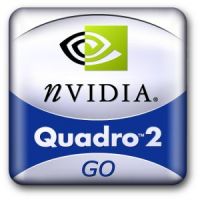
The NVIDIA Quadro2 Go is a hybrid of a professional and
mobile graphics solution. As we may suspect, such development
costs NVIDIA only a certification of professional drivers for the
GeForce2 Go, which we have already written about. But such certification
of drivers for basic professional packets, correspondence to the
OpenGL 1.3 standard and some hardware standards (SpeedStep, ACPI
etc.) costs much and brings problems. Besides, the company also
had to develop these drivers. But in this case it wasn't a problem:
the drivers are standard and changes are not great as compared with
Quadro MXR. In fact, an identification chip code is different. And
that's all. All professional possibilities are enabled in the drivers
on a program level, and there is even a utility which can get drivers
identify any card based on GeForce 256/2/3 chip as a corresponding
professional model.
Let's see what we receive from the name Quadro which covers the case
of the GeForce2 Go (together with the corresponding drivers):
- Everything that the GeForce 2 Go has in the maximum version (183 MHz 64-bit
DDR
or 128-bit SDR memory).
- Chip and driver certified for operation with Discreet® 3ds max(TM), Autodesk®
AutoCAD®, Dassault Catia®, SDRC I-DEAS(TM), Newtek Lightwave
3D(TM), Alias|Wavefront® Maya(TM), Autodesk Mechanical Desktop(TM), Bentley® MicroStation(TM),
PTC Pro/Engineer(TM), Softimage®/XSI, UGS® Solid Edge(TM), Solidworks®, UGS Unigraphics(TM)
and some other packets.
- Special drivers for 3ds max (with MAXtreme(TM) support) and AutoCAD
- NVIDIA's application QuadroView for viewing popular 3D formats
- Hardware pixel and line anti-aliasing
- OpenGL overlay support
- Support up to 8 2D clipping regions
- Two-side polygon lighting
- Multi-processor system support
- Certified compatibility with OpenGL 1.3
- Drivers for Linux, including OpenGL 1.2
The latter two items are a very useful feature: the Linux is used more
and more often on notebooks since it saves memory and consumes less energy.
As compared with the v1.2 the OGL 1.3 has received the following features:
- Cube map texturing
- Multisampling for AA
- New texturing modes:
- Texture Add Environment Mode
- Texture Combine Environment Mode
- Texture Dot3 Environment Mode
- Texture Filtering Mode
- Compressed texture formats support
Let's add the key characteristics of the GPU Quadro2 GO:
- Chip size: 31x31mm, case package: 560 BGA
- Technological process: 0.18 micron
- RAMDAC: 350 MHz, integrated, with palette mode support
- Maximum resolution: 2048x1536 @ 60 Hz
- Dual-channel LVDS transmitter, 24 bits, maximum resolution
on digital monitors - 1600x1200
- Fillrate: 286 Mpixel/sec
- HW T&L performance: 17M triangles/sec
- DDR (64bit bus) or SDR (128bit bus) local memory supported, 32 or 64 MBytes

Well, there are the chip, the drivers and the certificates. What then?
As you may remember, production of NVIDIA Quadro-series
based cards belongs to ELSA. But such approach doesn't
suit notebooks where a chip is installed into a finished sample,
and it is necessary to collaborate with several notebook manufacturers
in order to get some variety of solutions. First, they chose Fujitsu
Siemens Computers which had been connected with NVIDIA by the chipset
with integrated graphics - nForce.
It will be exactly Fujitsu Siemens which will release the first
notebook of the Celsius H series (with NVIDIA Quadro2 Go) of the
workstation class.
The price aspect is not that bad, as you may think. First, a notebook
costs more than a desktop PC; that is why the price difference between
the Quadro2 Go and a usual mobile chip vanishes away. Secondly, the price
will be lower than that of desktop systems at the very beginning, because
it is a new market and it is necessary to gain the ground there.
The ads of the first notebook demonstrate two workers
examining a 3D circuit of some tubes of communication on the notebook.
Well, I hope the product will be not only shockproff but also waterproff.
But whether it will sell good the time will show...
Write a comment below. No registration needed!
|
|
 |
|
|
|


